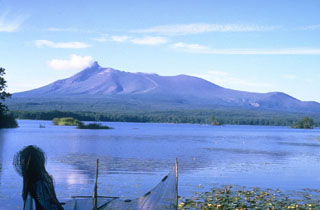Report on Hokkaido-Komagatake (Japan) — March 1996
Bulletin of the Global Volcanism Network, vol. 21, no. 3 (March 1996)
Managing Editor: Richard Wunderman.
Hokkaido-Komagatake (Japan) Additional information about the 5 March eruption
Please cite this report as:
Global Volcanism Program, 1996. Report on Hokkaido-Komagatake (Japan) (Wunderman, R., ed.). Bulletin of the Global Volcanism Network, 21:3. Smithsonian Institution. https://doi.org/10.5479/si.GVP.BGVN199603-285020
Hokkaido-Komagatake
Japan
42.063°N, 140.677°E; summit elev. 1131 m
All times are local (unless otherwise noted)
Volcanic tremor was registered for six minutes starting at 1810 on 5 March by the JMA station 4.1 km WSW of the crater. During this activity, two main vents opened on and near the S side of Showa 4-nen (1929) crater. A line of vents extending ~200 m N-S formed on the S part of the crater floor. Strong eruptive activity was observed until 7 March and then decreased. Volcanic earthquakes had increased somewhat prior to the eruption, but seismicity remained low afterwards through mid-April.
Geological Summary. Much of the truncated Hokkaido-Komagatake andesitic volcano on the Oshima Peninsula of southern Hokkaido is Pleistocene in age. The sharp-topped summit lies at the western side of a large breached crater that formed as a result of edifice collapse in 1640 CE. Hummocky debris avalanche material occurs at the base of the volcano on three sides. Two late-Pleistocene and two Holocene Plinian eruptions occurred prior to the first historical eruption in 1640, which began a period of more frequent explosive activity. The 1640 eruption, one of the largest in Japan during historical time, deposited ash as far away as central Honshu and produced a debris avalanche that reached the sea. The resulting tsunami caused 700 fatalities. Three Plinian eruptions have occurred since 1640; in 1694, 1856, and 1929.
Information Contacts: Volcanological Division, Seismological and Volcanological Department, Japan Meteorological Agency (JMA), 1-3-4 Ote-machi, Chiyoda-ku, Tokyo 100 Japan.

